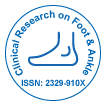Наша группа организует более 3000 глобальных конференций Ежегодные мероприятия в США, Европе и США. Азия при поддержке еще 1000 научных обществ и публикует более 700 Открытого доступа Журналы, в которых представлены более 50 000 выдающихся деятелей, авторитетных учёных, входящих в редколлегии.
Журналы открытого доступа набирают больше читателей и цитируемости
700 журналов и 15 000 000 читателей Каждый журнал получает более 25 000 читателей
Индексировано в
- Google Scholar
- Шерпа Ромео
- Открыть J-ворота
- Академические ключи
- РефСик
- Университет Хамдарда
- ЭБСКО, Аризона
- OCLC- WorldCat
- Публикации
- Женевский фонд медицинского образования и исследований
- Евро Паб
- ICMJE
Полезные ссылки
Журналы открытого доступа
Поделиться этой страницей
Абстрактный
Alterations in Evertor/Invertor Muscle Activation and Cop Trajectory during a Forward Lunge in Participants with Functional Ankle Instability
Ty Hopkins J, Mark Coglianese, Shane Reese and Matthew K Seele
Objectives: Participants with ankle instability demonstrate more foot inversion during the stance phase of gait than able-bodied subjects. Invertor excitation, in combination with evertor inhibition may contribute to this potentially injurious position. This alteration may be more pronounced when additional loads are placed on the foot during functional movements. The purpose of this experiment was to examine evertor/invertor muscle activation and foot center of pressure (COP) trajectory during foot loading in participants with functional ankle instability (FI).
Methods: Twelve subjects were identified with FI and matched to healthy controls. Tibialis anterior (TA) and peroneus longus (PL) electromyography (EMG), as well as COP, were recorded during the entire stance portion of a forward lunge. Functional analyses were used to detect differences between FI and control subjects with respect to normalized EMG amplitude and COP trajectory during the stance portion of the forward lunge.
Results: The functional analysis revealed no differences between groups during the stance phase of the lunge for PL EMG or COP. The FI group did exhibit significantly less TA activation at the beginning and end of stance. However, TA activation increased in the FI group relative to controls during the loading portion of stance.
Conclusion: While COP did not deviate during a loading task, the observed motor strategies could contribute to movement/stabilization alterations in a FI population. Treatment of FI should consider interventions focused on forcing normal activation of the invertors/evertors.
Журналы по темам
- Биохимия
- Ветеринары
- Генетика и молекулярная биология
- Геология и науки о Земле
- Еда и питание
- Иммунология и микробиология
- Инженерное дело
- Клинические науки
- Материаловедение
- медицинские науки
- Науки об окружающей среде
- Общая наука
- Сельское хозяйство и аквакультура
- Социальные и политические науки
- Уход и здравоохранение
- Фармацевтические науки
- Физика
- Химия

 English
English  Spanish
Spanish  Chinese
Chinese  German
German  French
French  Japanese
Japanese  Portuguese
Portuguese  Hindi
Hindi